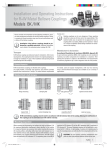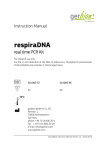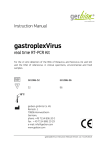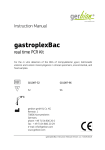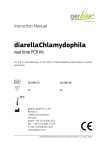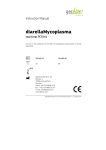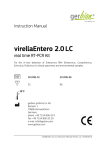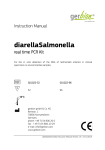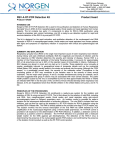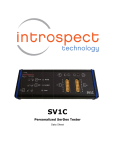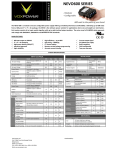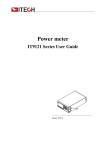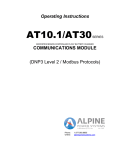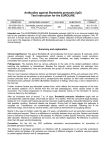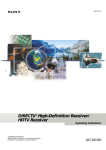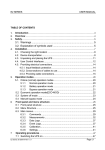Download G01084 - gerbion
Transcript
Instruction Manual respiraRNA 2.0 real time RT-PCR Kit For the in-vitro detection of the RNA of Influenza A virus, Influenza B virus and Respiratory Syncytial Virus in clinical specimens. G01084-32 G01084-96 32 96 gerbion gmbH & Co. KG Remsstr. 1 70806 Kornwestheim Germany phone: +49 7154 806 20 0 fax: + 49 7154 806 20 29 e-mail: [email protected] www.gerbion.com respiraRNA 2.0 Instruction Manual Version 2.1 / 05.05.2015 2 Index 1 Components.................................................................................................................................................... 3 2 Abbreviations ................................................................................................................................................. 3 3 Transport and Storage .............................................................................................................................. 3 4 Intended Use .................................................................................................................................................. 3 5 Sample Material ........................................................................................................................................... 4 6 Quality Control............................................................................................................................................... 4 7 Product Warranty ......................................................................................................................................... 4 8 Introduction ..................................................................................................................................................... 4 9 Principle of the Test.................................................................................................................................... 5 10 Equipment and Reagents to be Supplied by User...................................................................... 6 11 Important Notes ........................................................................................................................................... 6 12 General Precautions ................................................................................................................................... 6 13 Isolation of Viral RNA................................................................................................................................. 7 14 Control RNA (K5)........................................................................................................................................... 7 15 Real time RT-PCR ......................................................................................................................................... 8 15.1 Important Points Before Starting: .......................................................................................... 8 15.2 Procedure ............................................................................................................................................ 8 16 Data Analysis .............................................................................................................................................. 14 17 Troubleshooting ......................................................................................................................................... 17 18 Other Products ............................................................................................................................................ 19 respiraRNA 2.0 Instruction Manual Version 2.1 / 05.05.2015 3 1 Components The reagents supplied are sufficient for 32 or 96 reactions respectively. Table 1: Components of the respiraRNA real time RT-PCR kit. Label Lid Colour Content 32 K1 Reaction Mix K2 96 yellow 1 x 506 µl 2 x 759 µl Enzyme blue 1 x 6.4 µl 1 x 19.2 µl K3 Positive Control Influenza A, Influena B, RSV red 1 x 50 µl 1 x 100 µl K4 Negative Control green 1 x 50 µl 1 x 100 µl K5 Control RNA red 1 x 160 µl 2 x 240 µl 2 RNA PCR RT cDNA RSV 3 Abbreviations Ribonucleid Acid Polymerase Chain Reaction Reverse Transcription complementary Deoxyribonucleid Acid Respiratory Syncytial Virus Transport and Storage The respiraRNA 2.0 real time RT-PCR Kit is shipped on dry ice. All components must be stored at -18°C in the dark immediately after receipt. Do not use reagents after the date of expiry printed on the package. After initial usage, reagents are stable for up to six months. 4 Intended Use The respiraRNA 2.0 real time RT-PCR is an assay for the detection of RNA of Influenza A virus, RSV, Influenza B virus in clinical specimens (e.g. throat swabs, nasal swabs, bronchoalveolar lavage, liquor) using real time PCR microplate systems. respiraRNA 2.0 Instruction Manual Version 2.1 / 05.05.2015 4 5 Sample Material Starting material for the respiraRNA 2.0 real time RT-PCR is viral RNA isolated from clinical specimens (e.g. throat swabs, nasal swabs, bronchoalveolar lavage, liquor). 6 Quality Control In accordance with gerbion‘s ISO-certified Quality Management System, each lot of the respiraRNA 2.0 real time RT-PCR Kit is tested against predetermined specifications to ensure consistent product quality. 7 Product Warranty gerbion guarantees the performance of all products when used according to the instructions given in the Instruction Manual. The purchaser must determine the suitability of the product for its particular use. Should any product fail to perform satisfactorily due to any reason other than misuse, gerbion will replace it free of charge or refund the price. We reserve the right to change, alter, or modify any product to enhance its performance and design. 8 Introduction respiraRNA 2.0 is a multiplex real time RT-PCR for the detection of causative agents of respiratory diseases. The respiraRNA 2.0 real time RT-PCR is designated for pathogens with a RNA genome: Influenza virus A, Influenza virus B, RSV. In combination with NukEx PLUS 2.0 (gerbion Cat. No. G05016) for the preparation of throat swabs and nasal swabs, respiraRNA 2.0 real time RT-PCR allows for fast, efficient and cost effective diagnostics. Influenza viruses belong to the family of Orthomyxoviridae and are the causative agent of ‘the flu‘. Influenza A and B viruses have a single stranded RNA genome, consisting of 8 RNA segments. The genome of Influenza A viruses is characterized by a high mutation frequency the so-called ‚antigenic drift‘. Numerous subtypes of Influenza A viruses are known. They can be catergorized by their surface antigenes H (haemagglutinin) and N (neuraminidase): Influenza A (H1N1) Virus, Influenza A (H5N1) Virus etc. There are three ways of transmission of Influenza viruses: respiraRNA 2.0 Instruction Manual Version 2.1 / 05.05.2015 5 droplet infection: through inhalation of contaminated aerosols in the air contact infection: through direct contact with infected persons smear infection: through contaminated surfaces (e.g. door handle, telephone, etc.) According to the World Health Organisation’s (WHO) estimates 10 to 20 % of the world’s population are affected each year 80 % of all infections with Influenza virus remain unnoticed or proceed as a mild cold, while the remaining 20 % lead to severe disease. Symptoms usually occur suddenly. At first chills and general feeling of illness with fever up to 40°C occur. In the further course of the disease following symptoms are common: sore throat, dry cough, flu, nausea, headache, and limb pains. Most of the fatalities in connection with Influenza are not due to the primary virus infection but due to bacterial infections. These secondary infections lead to pneumonia, ear infection, and myocarditis. Respiratory Syncytial Viruses are enveloped negative-sense, single stranded RNA Viruses of the Paramyxoviridae familiy. RSV is a member of the subfamily Pneumovirinae, genus Pneumovirus. Human Respiratory Syncytial Viruses are divided into subgroups A and B. Transmission of the virus mainly takes place by smear and droplet infection. Typical symptoms are flu, acute bronchiolitis, and otitis media. Infants suffer from fever, coughing, and breathing difficulties. 5 % of the affected children develop pseudo croup. Further, SBV infections are considered to be a risk factor for sudden infant death syndrome (SIDS). 40 – 70% of all children undergo RSV infection under the age of 1. Nearly every child has once been infected by the end of the second year of their lives. Infection with RSV does not lead to immunity, re-infections can occur throughout life, causing mild symptoms in healthy persons. 9 Principle of the Test The respiraRNA 2.0 real time RT-PCR Kit contains specific primers and hydrolysis probes for the detection of the RNA of Influenza A virus, RSV and Influenza B virus in clinical specimens (e.g. throat swabs, nasal swabs, bronchoalveolar lavage, liquor) after the extraction of RNA from the sample material. The reverse transcription (RT) of viral RNA to cDNA and the subsequent amplification of virus specific fragments are performed in a onestep RT-PCR. The amplification can be detected when specific probes are hydrolysed by the Polymerase. The emitted fluorescence is measured in the FAM (Influenza A virus), ROX (RSV), and Cy5 (Influenza B virus) channel. respiraRNA 2.0 Instruction Manual Version 2.1 / 05.05.2015 6 Furthermore, the respiraRNA 2.0 real time PCR Kit contains a Control RNA (K5), which is detected in a second amplification system. Added during RNA extraction, the Control RNA (K5) allows not only for the detection of RT-PCR inhibition but also detects possible mistakes during RNA extraction. This greatly reduces the risk of false-negative results. The fluorescence of the Control RNA (K5) is measured in the VIC®/HEX/JOETM/TET channel. 10 Equipment and Reagents to be Supplied by User • RNA isolation kit (e.g. NukEx Pure RNA/DNA, gerbion Cat. No. G05004) or NukEx PLUS 2.0 Nucleic Acid Release Reagent (gerbion Cat. No. G05016) • Sterile microtubes • Pipets (adjustable volume) • Sterile pipet tips with filter • Table centrifuge • Vortexer • Real time PCR instrument • Optical PCR reaction tubes with lid • Optional: Liquid handling system for automation 11 Important Notes • The respiraRNA 2.0 real time RT-PCR must be performed by qualified personnel only. • Good Laboratory Practice (GLP) has to be applied. • Clinical samples must always be regarded as potentially infectious material and all equipment used has to be treated as potentially contaminated. 12 General Precautions • Stick to the protocol described in the Instruction Manual. • Set up different laboratory areas for the preparation of samples and for the set up of the RT-PCR in order to avoid contaminations. • Pipettes, tubes and other materials must not circulate between those different laboratory areas. • The Enzyme (K2) is liquid even at -18°C. Take it out of the freezer shortly before usage and put it back immediately. • Always use filter tips. • Regulary decontaminate equipment and benches with ethanohol-free decontaminant. respiraRNA 2.0 Instruction Manual Version 2.1 / 05.05.2015 7 • Do not combine respiraRNA 2.0 real time RT-PCR Kit components of different lot numbers. 13 Isolation of Viral RNA The respiraRNA 2.0 real time RT-PCR is suitable for the detection of Influenza A virus, RSV, Influenza B virus in clinical specimens (e.g. throat swabs, nasal swabs, bronchoalveolar lavage, liquor) isolated with suitable isolation methods. Commercial kits for RNA isolation such as the following are recommended: • NukEx Pure RNA/DNA, gerbion Cat. No. G05004 Alternatively RNA can be released from throat or nasal swabs with NukEx PLUS 2.0 Nucleic Acid Release Reagent (gerbion Cat. No. G05016). This is the fastest and most convenient method for the release of nucleic acid from swabs, because column based purification of the RNA can be omitted. More information can be found on www.gerbion.com. Important: In addition to the samples always run a “water control” in your extraction. Treat this water control analogous to a sample. Comparing the amplification of the Control RNA (K5) in the sample to the amplification of the internal control in the water control will give insights on possible inhibitions of the real time RT-PCR. Furthermore, possible contaminations during RNA extraction will be detectable. Please note the chapter ‚Control RNA‘ on page 7. If the real time RT-PCR is not performed immediately, store extracted RNA and NukEx PLUS 2.0 lysates according to the instructions given by the RNA extraction kit‘s manufacturer. Further information about RNA isolation is to be found in the extraction kit manual or from the extraction kit manufacturer‘s technical service. 14 Control RNA (K5) A Control RNA (K5) is supplied to be used as Extraction Control. This allows the user to control the RNA isolation procedure and to check for possible real time RT-PCR inhibition. Control RNA (K5) used as Extraction Control: respiraRNA 2.0 Control RNA (K5) is added prior to the RNA extraction. respiraRNA 2.0 Instruction Manual Version 2.1 / 05.05.2015 8 To this end, multiply the buffer volume needed per extraction with the number of samples (including at least one water control) (N) plus 1 to compensate for inaccuracies in pipetting (N+1). Add 5 µl Control RNA (K5) per extraction (5 µl x (N+1)). Mix well. Perform the RNA isolation according to the manufacturer‘s instructions. If the extraction protocol includes an incubation step of the sample in the first buffer, the Control RNA (K5) is to be added to each sample individually after incubation. The Control RNA (K5) must not be added to the sample material directly. Control RNA (K5) used as Internal Control of the real time RT-PCR : If crude NukEx PLUS 2.0 lysates are being used or control of the RNA extraction is not desired, the Control RNA (K5) can be used as Internal Control of the real time RT-PCR only. To that end, the Control RNA (K5) is to be added directly to the real time RT-PCR Master Mix. 15 Real time RT-PCR 15.1 Important Points Before Starting: • Please pay attention to the ‚Important Notes‘ on page 6. • Before setting up the real time RT-PCR familiarise yourself with the real time PCR instrument and read the user manual supplied with the instrument. • The programming of the thermal profile should take place before the PCR set up. • In every PCR run a Positive Control (K3) and one Negative Control (K4) should be included. • Before each use, all reagents - except the Enzyme (K2) - should be thawed completely at room temperature, thouroughly mixed (do NOT vortex the Reaction Mix (K1) but mix by pipetting up and down repeatedly), and centrifuged very briefly. Then place all reagents on ice or on a cooling block (+2 to +8°C). 15.2 Procedure If the Control RNA (K5) is used to control both the real time RT-PCR and the RNA isolation procedure, please follow protocol A. If the Control RNA (K5) is solely used to detect possible inhibition/failure of the real time RT-PCR, please follow protocol B. respiraRNA 2.0 Instruction Manual Version 2.1 / 05.05.2015 9 respiraRNA 2.0 Instruction Manual Version 2.1 / 05.05.2015 10 Protocol A The Control RNA (K5) was added during RNA extraction (see ‚Control RNA‘, page 7). In this case, prepare the Master Mix on ice or in a cooling block (+2 to +8°C) according to Table 2. The Master Mix contains all of the components needed for RT-PCR except the sample. Prepare a volume of Master Mix for at least one sample more than required, in order to compensate for pipetting inaccuracy. Table 2: Preparation of the Master Mix (Control RNA (K5) was added during RNA extraction) Volume per Reaction Volume Master Mix 15.8 µl Reaction Mix (K1) 15.8 µl x (N+1) 0.0 µl Control RNA (K5) 0.0 µl x (N+1) 0.2 µl Enzyme (K2) 0.2 µl x (N+1) Protocol B The Control RNA (K5) is used for the control of the real time RT-PCR only (see ‚Control RNA‘, page 7). In this case, prepare the Master Mix on ice or in a cooling block (+2 to +8°C) according to Table 3. The Master Mix contains all of the components needed for real RT-PCR except the sample. Prepare a volume of Master Mix for at least one sample more than required, in order to compensate for pipetting inaccuracy. Important: Dilute the Control RNA (K5) 1:10 in sterile dH2O (e.g. 1 µl Control RNA (K5) + 9 µl dH2O) before adding it to the Master Mix. respiraRNA 2.0 Instruction Manual Version 2.1 / 05.05.2015 11 Table 3: Preparation of the Master Mix (Control RNA (K5) is added directly to the Master Mix) Volume per Reaction Volume Master Mix 15.8 µl Reaction Mix (K1) 15.8 µl x (N+1) 0.2 µl Control RNA (K5)* (diluted 1:10) 0.2 µl x (N+1)* 0.2 µl Enzyme (K2) 0.2 µl x (N+1) *The increase in volume caused by adding the Control RNA is not taken into account when preparing the PCR assay. The sensitivity of the detection system is not impaired. Protocol A and B: real time RT-PCR set up Important: Crude NukEx PLUS 2.0 lysates must be inactivated prior to adding them to the real time PCR mix! • Put the number of optical PCR reaction tubes needed into the cooling block. • Pipet 16 µl of the Master Mix into each optical PCR reaction tube. • Add 4 µl of the eluates from the RNA isolation (including the eluate of the water control) or inactivated crude NukEx PLUS lysates, the Positive Controls (K3, K4, K5), and the Negative Control (K4) to the corresponding optical PCR reaction tube (Table 4). • Close the optical PCR reaction tubes immediately after filling in order to reduce the risk of contamination. Table 4: Preparation of the real time PCR Component Volume Master Mix 16.0 µl Sample 4.0 µl Total Volume 20.0 µl respiraRNA 2.0 Instruction Manual Version 2.1 / 05.05.2015 12 For the real time RT-PCR use the thermal profile shown in Table 5. Table 5: real time RT-PCR thermal profile Discription Time Temperature Number of Cycles Reverse Transcription 10 min 45°C 1 Initial Denaturation 5 min 95°C 1 Denaturation 10 sec 95°C Annealing and Extension 40 sec 60°C Aquisition at the end of this step Amplification of cDNA 45 Important: Crude NukEx PLUS 2.0 lysates must be inactivated prior to adding them to the real time PCR mix when performing a reverse transcriptase step prior to the initial denaturation! Dependent on the real time instrument used, further instrument settings have to be adjusted according to Table 6. respiraRNA 2.0 Instruction Manual Version 2.1 / 05.05.2015 13 Table 6: Overview of the instrument settings required for the respiraDNA real time PCR. Real time RT-PCR Insttrument LightCycler 480I LightCycler 480II Stratagene Mx3000P / Mx3005P ABI 7500 Rotor-Gene Q, Rotor-Gene 3000 Rotor-Gene 6000 Parameter Detection Channel Influenza A Virus 483-533 RSV 558-610 Control RNA 523-568 Influenza B Virus 615-670 Influenza A Virus 465-510 Notes Color Compensation Kit Multiplex 1 (G070MP1-cc) required RSV 533-610 Control RNA 498-580 Influenza B Virus 618-660 Influenza A Virus FAM Gain 8 RSV ROX Gain 1 Control RNA HEX Gain 1 Influenza B Virus Cy5 Gain 4 Influenza A Virus FAM RSV ROX Control RNA JOE Influenza B Virus Cy5 Influenza A Virus Green RSV Orange Control RNA Yellow Influenza B Virus Red Reference Dye: None Option Reference Dye ROX: NO respiraRNA 2.0 Instruction Manual Version 2.1 / 05.05.2015 14 16 Data Analysis The Influenza A virus specific amplification is measured in the FAM channel, the Respiratory Syncytial Virus specific amplification in the ROX channel and the Influenza B virus specific amplification in the Cy 5 channel. The amplification of the Control RNA (K5) is measured in the VIC®/HEX/JOETM/TET channel. Following results can occur: • A signal in the FAM channel is detected: The result is positive, the sample contains Influenza A virus RNA. In this case, detection of a signal of the Control RNA (K5) in the VIC®/HEX/JOETM/TET channel is inessential, as high concentrations of cDNA may reduce or completely inhibit amplification of the Control RNA (K5). • A signal in the ROX channel is detected: The result is positive, the sample contains Respiratory Syncytial Virus RNA. In this case, detection of a signal of the Control RNA (K5) in the VIC®/HEX/JOETM/TET channel is inessential, as high concentrations of cDNA may reduce or completely inhibit amplification of the Control RNA (K5). • A signal in the Cy 5 channel is detected: The result is positive, the sample contains Influenza B virus RNA. In this case, detection of a signal of the Control RNA (K5) in the VIC®/HEX/JOETM/TET channel is inessential, as high concentrations of cDNA may reduce or completely inhibit amplification of the Control RNA (K5). • No signal in the FAM, ROX and Cy5 channel, but a signal in the VIC®/HEX/JOETM/TET channel is detected: The result is negative, the sample does neither contain Influenza A virus RNA nor Respiratory Syncytial Virus RNA nor Influenza B virus RNA. The signal of the Control RNA (K5) excludes the possibilities of RNA isolation failure (in case the Control RNA (K5) is being used as an Extraction Control) and/or real time RT-PCR inhibition. If the CT value of a sample differs significantly from the CT value of the water control, a partial inhibition occured, which can lead to negative results in weak positive samples (see „Troubleshooting“, page 17). respiraRNA 2.0 Instruction Manual Version 2.1 / 05.05.2015 15 • Neither in the FAM, ROX, Cy 5 nor in the VIC®/HEX/JOETM/TET channel a signal is detected: A diagnostic statement cannot be made. The RNA isolation was not successful or an inhibition of the RT-PCR has occurred. In case the Control RNA (K5) was added during RNA isolation and not directly to the PCR Master Mix, the Negative Control (K4) is negative in both channels. respiraRNA 2.0 Instruction Manual Version 2.1 / 05.05.2015 16 Figure 1 and Figure 2 shhow examples for ppositive and negativve real time RTPC CR results. Figuree 1: The positive sam mple shows virus-speccific amplification in the FAM channel, whereeas no fluorescence signal is detected in thee negative sample. Figuree 2: The positive sam mple as well as the nnegative sample show a signal in the Controol RNA-specific VIC® ®/HEX/JOETM/TET channnel. The amplificatioon signal of the Controol RNA (K5) in the neegative sample shows, that the missing signal in the virusspeciffic FAM channel is nott due to RT-PCR inhibition or failure of RNA isolation, but that the sa ample is a true negativve. respiraRNA 2.0 Instruction Manual Versiion 2.1 / 05.05.2015 17 17 Troubleshooting The following troubleshooting guide is included to help you with possible problems that may arise when performing a real time RT-PCR. If you have further questions, please do not hesitate to contact our scientists on [email protected]. No fluorescence signal in the FAM, ROX, Cy 5 channel of the Positive Controls (K3, K4, K5) The selected channel for Select the FAM channel for analysis of the Norovirus analysis does not comply specific amplification, the ROX channel for analysis of with the protocol the Rotavirus specific amplification, the Cy 5 channel for analysis of the Adenovirus specific amplification and the VIC®/HEX/JOETM/TET channel for the amplification of the Control RNA (K5). Due to amplification in all three specific channels, amplification of the Internal Control can be inhibited in the Positive Control (K3). Incorrect configuration of Check your work steps and compare with ‚Procedure‘ the real time RT-PCR on page 8. The programming of the Compare the thermal profile with the protocol (Table thermal profile is incorrect 5, page 12). Incorrect storage conditions Check the storage conditions and the date of expiry for one or more kit printed on the kit label. If necessary, use a new kit and components or kit expired make sure kit components are stored as described in ‚Transport and Storage‘, page 3. Weak or no signal of the Control RNA (K5) and simultaneous absence of a signal in the virus specific FAM channel, ROX channel or Cy 5 channel. real time RT-PCR conditions do not comply with the protocol real time RT-PCR inhibited Check the real time RT-PCR conditions (page 8). Make sure that you use an appropriate isolation method (see ‚Isolation of Viral RNA‘, page 7) and follow the manufacturer‘s instructions. Make sure that the ethanol-containing washing buffer of the isolation kit has been completely removed. An additional centrifugation step at high speed is recommended before elution of the RNA. Dilute NukEx PLUS 2.0 lysates 1:3 in dH2O or NukEx Universal Dilution Buffer (gerbion, Cat. No. G01014). Alternatively, purify the respiraRNA 2.0 Instruction Manual Version 2.1 / 05.05.2015 18 lysates with e.g. NukEx Pure RNA/DNA Kit (gerbion, Cat. No. G05004). RNA loss during isolation In case the Control RNA (K5) was added before process extraction, the lack of an amplification signal can indicate that the RNA isolation was not successful. Make sure that you use an appropriate isolation method (commercial kits are recommended) and stick to the manufacturer‘s protocol. NukEx PLUS 2.0 crude Crude NukEx PLUS lysates must be inactivated prior to lysates not inactivated adding them to the real time (RT-) PCR mix when performing a reverse transcriptase step prior to the initial denaturation! Incorrect storage conditions Check the storage conditions and the date of expiry for one or more printed on the kit label. If necessary, use a new kit and components or kit expired make sure kit components are stored as described in ‚Transport and Storage‘, page 3. Detection of a weak fluorescence signal in the FAM channel of a sample with a strong fluorescence signal in the Cy5 channel. Cross-talk Depending on the real time PCR instrument used, a strong fluorescence signal in one detection channel can lead to a weak signal (around CT 40) in another channel due to so-called cross-talk between channels. Detection of a fluorescence signal in the FAM channel, ROX channel or Cy 5 channel of the Negative Control (K4) Contamination during Repeat the real time RT-PCR in replicates. If the result is negative in the repetition, the contamination preparation of the RT-PCR occured when the samples were pipetted into the optical PCR reaction tubes. Make sure to pipet the Positive Control (K3) last and close the optical PCR reaction tube immediately after adding the sample. If the same result occurs, one or more of the kit components might be contaminated. Make sure that work space and instruments are decontaminated regularly. Use a new kit and repeat the real time RTPCR. respiraRNA 2.0 Instruction Manual Version 2.1 / 05.05.2015 19 18 Other Products A number of products related to real time PCR and nucleic acid isolation is available from gerbion GmbH & Co. KG. More information as well as the complete Product Catalogue is available on www.gerbion.com. Product Description Cat. No. NukEx Pure RNA/DNA Spin column-based kit for the isolation of RNA and DNA from a variety of sample matrices. For 50 or 200 extractions. G05004-50 G05004-200 NukEx Collection Tubes 500 NukEx Collection Tubes for use with NukEx Spin Columns. G06008 NukEx PLUS 2.0 Reagent for the enzymatic release of nucleic acids from swabs and cell culture suspensions. Very fast and convinient protocol! Including NukEx Stop for chemical inactivation. G05016 NukEx Pestle 1.5 ml 100 disposable PBTP pestles for use in 1.5 ml reaction tubes. Individually packed. DNase-free, RNase-free, nonpyrogenic. G06006 NukEx TS Shredding material aliquoted in 1.5 or 2.0 ml safe lock tubes or 2.0 ml screw cap tubes for the manual preparation of samples such as tissue or insects. G06007-1.5 G06007-2.0 G06007-2.0 sc Proteinase K Proteinase K, Molecular Biology Grade, from Tritirachium album. 100 mg. G07001 respiraRNA 2.0 Instruction Manual Version 2.1 / 05.05.2015



















